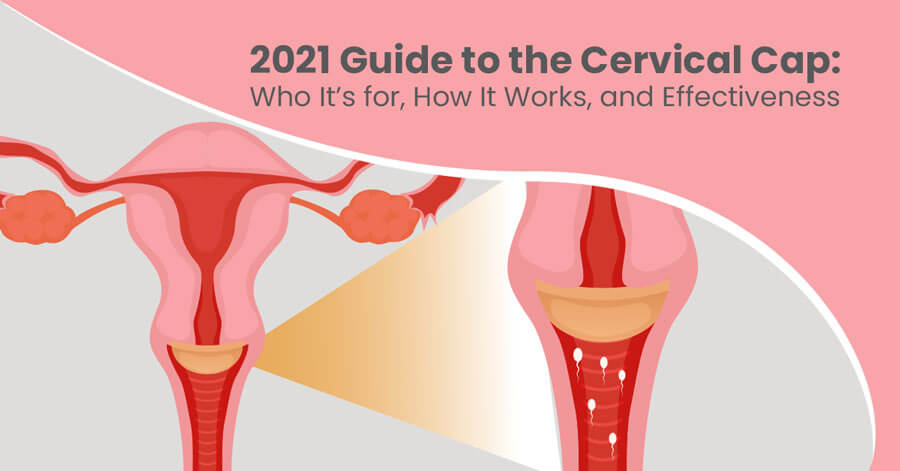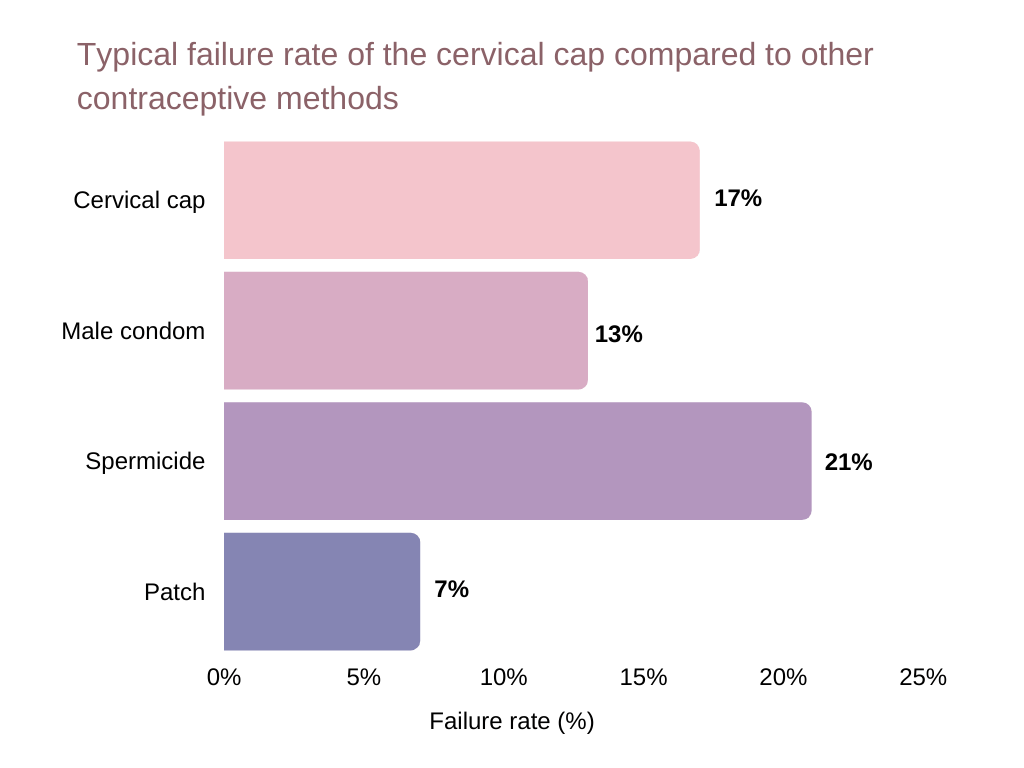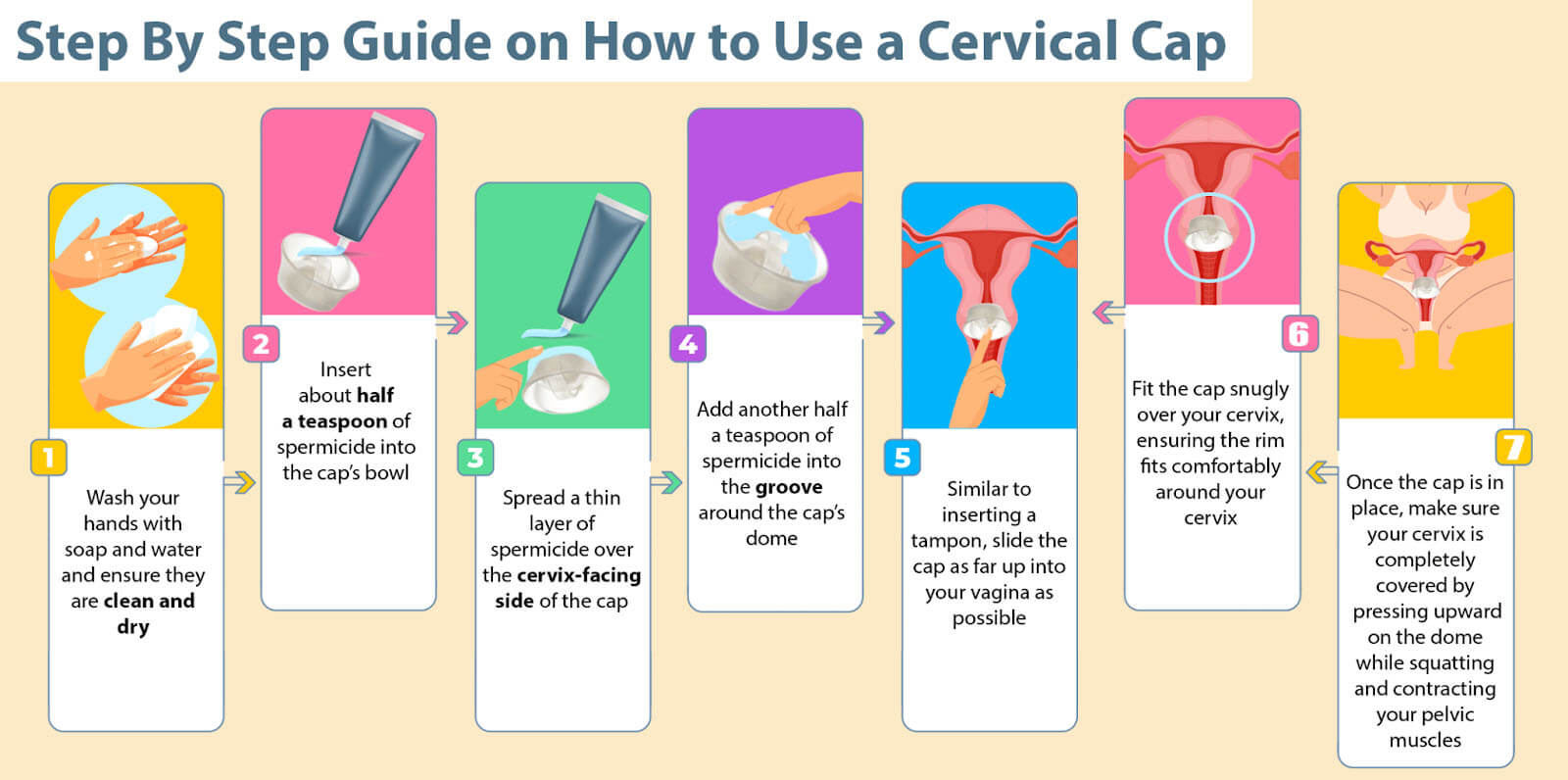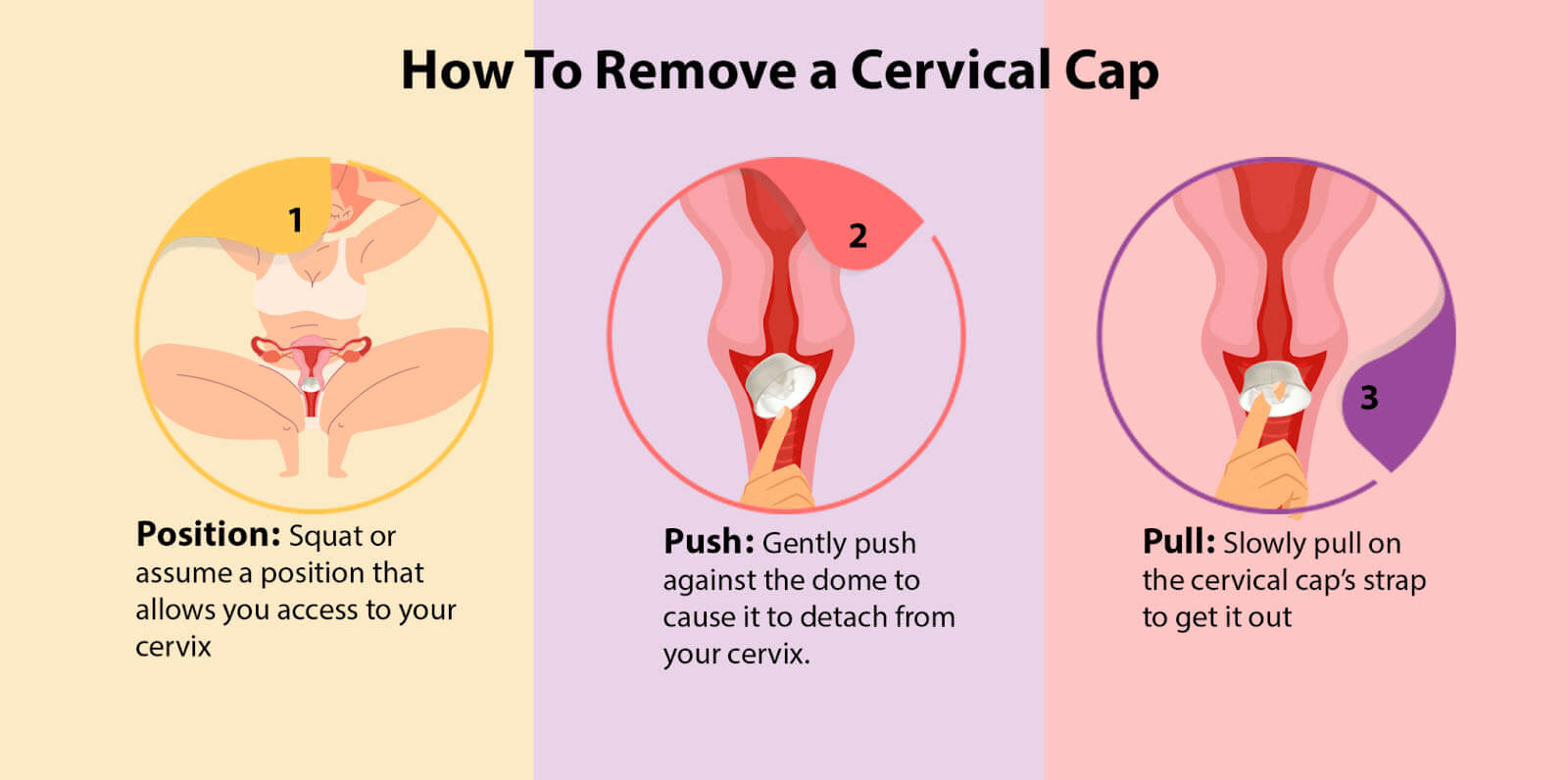
Contraceptive technology covers a huge range of birth control options, from the cervical cap to hormonal IUDs.
Deciding which is best for you can feel nearly impossible, especially with the long lists of side effects and contraindications. Fortunately, the cervical cap offers little to no adverse effects and can be used by almost anyone.
This article covers how it works, who it is suited for, and compares it to other popular contraceptive methods.
Key Takeaways
- Cervical caps are a barrier method of preventing pregnancy
- A cervical cap blocks sperm from the uterus
- It is most effective when used in combination with spermicides
- It can be kept in place for up to 48 hours
- It is reusable
What Is the Cervical Cap?
The cervical cap is a non-hormonal, barrier form of birth control. It looks like a thimble-shaped cup and is inserted deep into the vagina to cover the cervix and block the path of sperm to the uterus.
How Does a Cervical Cap Work
This barrier method of birth control helps prevent pregnancy as a cervical cap keeps sperm from entering the uterus and reaching an egg. Cervical caps are made from soft, flexible silicone. When inserted into the vagina, a cervical cap covers your cervix completely, forming a sealed dome.
Is It Safe?
The Food and Drug Administration (FDA) has approved cervical caps as a safe, effective form of birth control.
Who Is the Cervical Cap Right For?
Cervical caps are generally not recommended for most young women. This is because it can be difficult to insert correctly and can result in a high risk of accidental pregnancy if it doesn’t cover the cervix entirely or moves during intercourse.
Making sure the cap is in place involves inserting your finger deep into the vagina, which may feel intrusive and uncomfortable to some, and discourage them from using the cap.
The best way to choose the right birth control method for you is to discuss your options with your doctor or the healthcare providers at any planned parenthood center.
Effectiveness of the Cervical Cap
The cervical cap is an effective method of birth control as shown:
- To prevent pregnancy: A cap is effective over 80% of the time.
- STD Prevention: Cervical caps don’t protect against STDs.
Pregnancy
The cervical cap alone prevents pregnancy around 80% of the time with correct and typical use [2].

Source: https://www.cdc.gov/reproductivehealth/contraception/index.htm
However, the chances of an accidental pregnancy increase if you have given birth, especially if the same cap from before is reused.
This is because vaginal birth changes the shape of the cervix and vagina and can result in the cap not fitting correctly or sliding around during intercourse, letting sperm through [3].
How Effective Is the Cervical Cap With Spermicides?
Most doctors recommend adding spermicide to the cap before insertion to provide added protection while using the cervical cap. Combining these two measures provides protection against pregnancy 93.9% of the time [4].
Spermicides are a common additional contraceptive measure and accompany other barrier methods like the birth control sponge and diaphragm. Spermicides come in foams, creams, and gels and work by either slowing sperm down or killing them entirely.
The only drawback of using spermicides for extra protection is that the chemicals may irritate the vagina and surrounding skin, increasing the risk of getting a bacterial infection, UTI, or sexually transmitted disease [5, 6].
STDs
Unlike other barrier contraceptives, including the male and female condom, the cervical cap doesn’t provide much protection against sexually transmitted diseases (STDs) [7].
Can You Make the Cervical Cap More Effective?
Ways to make a cervical cap more effective include using spermicide or adding more spermicide when you begin a new sex act. You can also use cervical caps alongside other contraceptive measures like birth control pills or male condoms.
Diaphragm vs. Cervical Cap
Both the diaphragm and cervical cap work to prevent sperm from entering the uterus and may contain spermicide. However, the diaphragm is a shallower latex cup that can be left in place for 24 hours. The cervical cap has a deeper cup, is made of silicone, and can be left in place for up to 48 hours.
Despite the diaphragm being slightly more effective than the cervical cap at preventing pregnancy, most women who still choose the cervical cap do so because they can use it for longer [8].
If you’re unsure which method is right for you, consult your doctor, or visit a planned parenthood center that can help you assess your options, including less common methods like the copper IUD.
How To Use the Cervical Cap: Step by Step Guide
Before inserting the cervical cap, make sure it is the right size cap for you. Your doctor can do this through a pelvic exam.
To use the cervical cap, follow these steps:

- Wash your hands with soap and water and ensure they are clean and dry
- Insert about half a teaspoon of spermicide into the cap’s bowl
- Spread a thin layer of spermicide over the cervix-facing side of the cap
- Add another half a teaspoon of spermicide into the groove around the cap’s dome
- Similar to inserting a tampon, slide the cap as far up into your vagina as possible
- Fit the cap snugly over your cervix, ensuring the rim fits comfortably around your cervix
- Once the cap is in place, make sure your cervix is completely covered by pressing upward on the dome while squatting and contracting your pelvic muscles
How To Remove the Cervical Cap
After having sex, leave the cervical cap in place for at least six hours.
To remove it:

- Position: Squat or assume a position that allows you access to your cervix
- Push: Gently push against the dome to cause it to detach from your cervix.
- Pull: Slowly pull on the cervical cap’s strap to get it out
If you’re struggling to remove it, wait a few minutes until your muscles are completely relaxed, then try again.
How Long Can You Leave It In?
The cervical cap can be left in place for up to 48 hours [9].
Can You Use the Cervical Cap During Your Period?
No, you should not use the cap during menstruation as it blocks the path of blood out of your uterus [10].
How to Care for a Cervical Cap
After use, wash your cervical cap with warm water and mild soap. Allow it to air dry, and place it back in its case.
It must be air-dried as wiping it with a cloth could create tears or holes in the material. Regularly check for any such damage to the cap before usage.
Never use the cervical cap alongside oil-based lubricants, petroleum jelly, mineral oil, baby oil, or other vaginal creams, as they could also damage and reduce its effectiveness.
Similarly, never coat the cap with baby powder, not even for storage.
Advantages and Disadvantages
Below are some of the most significant pros and cons of cervical caps.
Advantages of the Cervical Cap
- Effective at preventing pregnancy when used with spermicide
- Reusable
- Can stay in place for up to 48 hours
- Little to no side effects
- Widely available
Disadvantages of the Cervical Cap
- Might increase the risk of toxic shock syndrome [11]
- Can result in accidental pregnancy if not inserted correctly
- Requires a prescription from a doctor
- Not as effective as other barrier methods like the diaphragm
- It can be challenging to use
FAQ
Here, we answer the most common questions about the cervical cap.
Can a Man Feel a Cervical Cap?
When inserted perfectly, your partner shouldn’t be able to feel the cap. However, if it’s not fitted correctly or is the wrong size, they may feel the rim or handle.
Where Can You Get a Cervical Cap?
The only cervical cap available in the US is the FemCap. The cervical cap requires a prescription from your doctor and can be purchased online or from family planning clinics and planned parenthood centers.
Does a Cervical Cap Hurt?
The cap itself shouldn’t cause pain, but the spermicide may create irritation inside your vagina or on your partner’s penis.
Can You Pee With a Cervical Cap In?
Yes, you can pee while the cervical cap is inserted. It does not block any part of your urinary tract.
How Long Does a Cervical Cap Last?
The cervical cap (FemCap) can last for up to a year with proper care.
Conclusion
Despite the slightly challenging insertion process of the cervical cap, it remains the preferred contraceptive method for millions of women worldwide.
Due to its non-hormonal nature, the cervical cap can be a great choice if you’re looking to try a low-maintenance, side-effect-free form of birth control.
References:
- Abdel-Salam, Omar M E, et al. “Citric Acid Effects on Brain and Liver Oxidative Stress in Lipopolysaccharide-Treated Mice.” Journal of Medicinal Food, Mary Ann Liebert, Inc., May 2014, www.ncbi.nlm.nih.gov/pmc/articles/PMC4026104/.
- D;, Boehm. “The Cervical Cap: Effectiveness as a Contraceptive.” Journal of Nurse-Midwifery, U.S. National Library of Medicine, pubmed.ncbi.nlm.nih.gov/6551434/.
- “What Is Best Birth Control to Use after Having a Baby?” Contraceptive Technology Update, U.S. National Library of Medicine, pubmed.ncbi.nlm.nih.gov/12342589/.
- Richwald GA;Greenland S;Gerber MM;Potik R;Kersey L;Comas MA; “Effectiveness of the Cavity-Rim Cervical Cap: Results of a Large Clinical Study.” Obstetrics and GyAbdel-Salam, Omar M E, et al. “Citric Acid Effects on Brain and Liver Oxidative Stress in Lipopolysaccharide-Treated Mice.” Journal of Medicinal Food, Mary Ann Liebert, Inc., May 2014, www.ncbi.nlm.nih.gov/pmc/articles/PMC4026104/.
- necology, U.S. National Library of Medicine, pubmed.ncbi.nlm.nih.gov/2664609/.
- Abdel-Salam, Omar M E, et al. “Citric Acid Effects on Brain and Liver Oxidative Stress in Lipopolysaccharide-Treated Mice.” Journal of Medicinal Food, Mary Ann Liebert, Inc., May 2014, www.ncbi.nlm.nih.gov/pmc/articles/PMC4026104/.
- Abdel-Salam, Omar M E, et al. “Citric Acid Effects on Brain and Liver Oxidative Stress in Lipopolysaccharide-Treated Mice.” Journal of Medicinal Food, Mary Ann Liebert, Inc., May 2014, www.ncbi.nlm.nih.gov/pmc/articles/PMC4026104/.
- Abdel-Salam, Omar M E, et al. “Citric Acid Effects on Brain and Liver Oxidative Stress in Lipopolysaccharide-Treated Mice.” Journal of Medicinal Food, Mary Ann Liebert, Inc., May 2014, www.ncbi.nlm.nih.gov/pmc/articles/PMC4026104/.
- Abdel-Salam, Omar M E, et al. “Citric Acid Effects on Brain and Liver Oxidative Stress in Lipopolysaccharide-Treated Mice.” Journal of Medicinal Food, Mary Ann Liebert, Inc., May 2014, www.ncbi.nlm.nih.gov/pmc/articles/PMC4026104/.
- Abdel-Salam, Omar M E, et al. “Citric Acid Effects on Brain and Liver Oxidative Stress in Lipopolysaccharide-Treated Mice.” Journal of Medicinal Food, Mary Ann Liebert, Inc., May 2014, www.ncbi.nlm.nih.gov/pmc/articles/PMC4026104/.
- Abdel-Salam, Omar M E, et al. “Citric Acid Effects on Brain and Liver Oxidative Stress in Lipopolysaccharide-Treated Mice.” Journal of Medicinal Food, Mary Ann Liebert, Inc., May 2014, www.ncbi.nlm.nih.gov/pmc/articles/PMC4026104/.



Leave a Reply